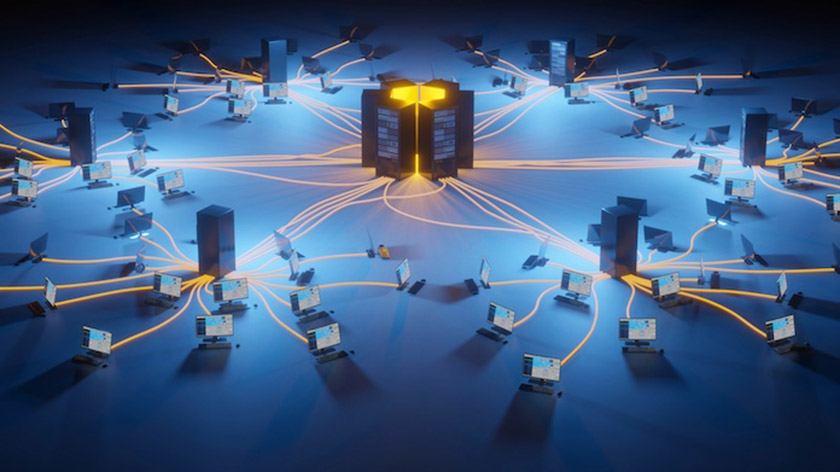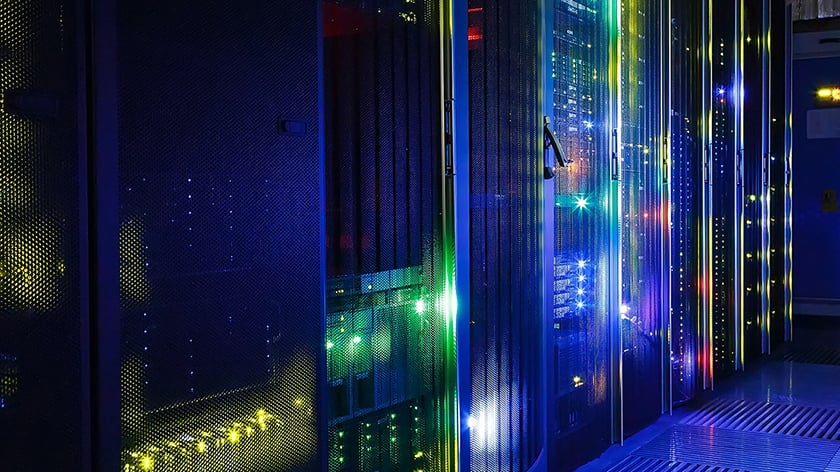Installing Packet Power Environmental Monitors [VIDEO]
Monitoring the environmental conditions (temperature, humidity, and differential air pressure) anywhere is a breeze with Packet Power devices. They...
6 min read
![]() Packet Power Team
:
Jul 9, 2014 12:23:00 PM
Packet Power Team
:
Jul 9, 2014 12:23:00 PM

Have you already gone wireless or are you still dealing with cables?
A different approach to integrated power and environment monitoring in data centres. By Jörg Poschen, Senior Marketing Manager at Daxten (Packet Power EU Partner)
Everyone knows that if you want to improve something, you have to be able to measure it. Which explains the current market boom for monitoring power and environmental parameters in data centres: monitoring tools have proven to have a wide range of applications, offering users a number of functional advantages and many benefits.
The routine work of monitoring tools lies in capturing and tracking vital data on power usage and environmental conditions, making it available to data center and facility operators for analysis and issuing alerts if critical thresholds are reached. System disruptions and downtime can be prevented, on the one hand, because problematic temperatures or a fluctuating power supplies are detected at an early stage.
On the other hand, the systems don’t just function as early warning systems for monitoring risks, they also help pinpoint energy-related or thermal weaknesses in a data centre environment. Monitoring solutions therefore supply the parameters needed to analyze, and ultimately optimize, how resources are used by IT equipment and the surrounding infrastructure. In the end, capacity utilization can be improved, energy consumption significantly reduced and CO2 emissions lowered as a result and a contribution made to lowering costs and protecting the environment. And in light of the fact that power consumption is one of the fastest growing cost factors in data centres, this is certainly no small matter.
The question for data centre decision-makers, given these numerous and valid reasons in favour of power and environmental monitoring, is not usually if they will deploy this kind of system now or in the near future, but which system is most suited to meet their current and future needs.
What solutions exist?
There are many types of power and environmental monitoring solutions available on the market. Their basic structure generally consists of a hardware, software or web-based management system and monitoring or sensor modules that either perform their monitoring activities as a stand-alone unit or, e.g. integrated into PDU strips. Depending on the requirement and which solution is chosen, a point-to-point or mesh monitoring structure can be set up in data centre environments.
The monitoring modules traditionally route the captured power and environmental data over a serial connection or bus system to a proprietary management platform.
The data is read, logged and converted so it can then be incorporated into an overarching data centre management system via SNMP, Modbus, BACnet or other protocols. One solution, called Packet Power, is unique: it handles communication between the sensor and measurement modules as well as data transfer to an SNMP or Modbus gateway wire-free without a single cable. Because this solution is so different from the vast majority of systems on the market, its functionality and properties are described below and compared to those of conventional monitoring technologies.
Wire-free technology has long come of age
Before we really delve into the material, let’s first challenge the claim that “wireless technology doesn’t belong in a data centre”. This concern, which stems from past experience, is related to its compatibility with other IT devices in individual cases or is the expression of a general worry about security. It can be argued that today’s wireless technologies, e.g. with 863 to 868 MHz, 902 to 927 MHz, 2.4 GHz or RFID, use country and needs-specific communication channels, frequencies or protocols or those that have been optimized for data centre monitoring.
According to the manufacturer of Packet Power, all communication is secure, distributed to packets and completely encrypted depending on what is needed. The technology coexists well with other wireless services in the building, has high interference immunity and uses dynamic frequency bands which prevent interference with other equipment in data centres. Additional security features and protective functions are explained below.
Wire-free solution vs. cable-based monitoring system
Wire-free monitoring solutions integrate the module that measures the power parameters right into the power cord. It simply replaces the conventional network cables that IT equipment and components are normally equipped with. Conventional power supply cables, PDUs und plug-in boxes can be retrofitted accordingly for 110 to 240 VAC and 16, 32 or 63 amps. The monitoring devices can also be integrated into the end feed units and branch circuits for 1- or 3-phase power of 10 to 2000 amps. The power readings, such as volts, amps, watts, power consumption, frequency, power factor, apparent power or power peaks, can be allocated to the individual devices in a room. Power monitoring is therefore more detailed than if the equipment is grouped by PDU strips or monitored as a large distribution unit per rack as is the case with other solutions.
Installation and configuration
Experienced data centre or facility operators notice the biggest difference when it comes to implementing the wireless system: once the units for environmental monitoring are positioned and activated and the power cords with the integrated monitoring modules connected, they start to configure themselves automatically, to take measurements and share their data in the wire-free network. The time it usually takes to connect the cables and configure other monitoring solutions is no longer necessary.
The data collected wirelessly is consolidated centrally to a gateway which transmits it via SNMP or Modbus either to a dedicated user interface as a software, web or cloud application or to existing data centre infrastructure management (DCIM) or building management system (BMS) solutions. The system’s management tool creates actual and trend reports on power usage at building, room, branch circuit, rack or device level on the basis of these readings and tracks environmental parameters for every room, rack row, rack or for the various levels and heights in an individual cabinet and shows them graphically. The consumption data for every IT device, the utilization of branch circuits and individual outputs as well as rack temperature, pressure and humidity information, power costs and CO2 emissions are shown in dashboard displays or in table format. Just as with the management platforms of other monitoring systems, limits can be defined ahead of times for critical power and environmental values so that, when exceeded, an automatic alert is triggered via SNMP or e-mail.
Scalability and capacity
If more capacity is needed, the new environmental or power monitoring module is simply placed in the appropriate location and/or connected to devices such as the power cable or integrated into a plug-in box. The remaining steps, as already described, are almost fully automated and the modules configure themselves.
An SME version of the gateway converts and transfers the data of up to 250 monitoring modules. The enterprise version uses multiple gateways to handle up to 2,000 units. The number of sensor and measurement modules is theoretically not limited and can be increased by simply adding gateways. Existing monitoring modules from third-party suppliers can be integrated into the management system as long as they communicate via TXT, HTML, CSV, XML, SNMP or Modbus over TCP.
Redundancy and security
As is the case with cable-based monitoring systems, the transmitted data is time-stamped, logged by an administration tool and saved so that it is available at any time. The readings can be transferred in a wire-free system encrypted just as in a cable or IP-based solution. In the event of a network disruption or power outage, a keep-alive function integrated in the monitoring module of the Packet Power solution prevents the recorded data from being lost.
In addition to a primary gateway instance in an environment, multiple redundancy can be created by configuring one, two or more additional backup gateways. Because the gateways synchronize their databases in very short cycles, the data is completely retained even if operations are disrupted for longer periods of time or if a power supply line completely fails.
To ensure that only authorized personnel has access to the captured data and the associated log files and reports, hierarchically structured access levels can be configured using the wireless system’s management system which are also components of conventional monitoring systems. In addition to providing heightened security, this is another, completely concrete benefit in terms of, for example, colocation, hosting or housing providers: it gives them the capability to provide their customers with dedicated power usage and performance reports as well as billing information.
Conclusions
Solutions for monitoring power and environmental parameters act as a kind of cockpit for data centre operators, allowing them to manage IT resources and energy more efficiently and sustainably and lower power consumption and CO2 emissions.
As monitoring and management tools, they monitor the power losses and utilization of branch circuits and outputs and track environmental parameters. They trigger alerts in the event of irregularities or excessive power supply or when temperatures and other critical environmental conditions change for the worse.
In addition, they function as optimization tools that can identify performance limits or reserves and configure better load distribution in data centres. Last but not least, these kinds of systems are also evaluation tools which allow the success of measures designed to use power more efficiently to be assessed and verified in the first place. In this field, they supply the data to reliably and continuously determine the PUE (Power Usage Effectiveness) or for individual KPIs (Key Performance Indicators) and performance parameters to assess the efficiency of the relationship between energy consumption and performance in a data centre environment.
As shown, wire-free monitoring solutions offer the entire range of functions and are an interesting alternative to cable-based or IP-based monitoring systems.
These systems score points with their simple, fast and cable-free installation in existing environments as well as the automatic self-configuration of their monitoring modules.
Users may also find it appealing that they can start small and scale the modularly structured system to meet to their needs with no limits.
Another advantage is that monitoring units already in use can also be integrated into the system. Users also like the concept for backup and data retention with the keep-alive functionality and the capability to create multiple redundancy with multiple gateways. System administration is user-friendly via a dedicated user interface or an overarching DCIM or BMS solution.
In a nutshell: if you want to improve something, you have to be able to measure it – and the better the measurement tool, the greater the improvement.


Read more: http://dcseurope.info/news_full.php?id=33638#ixzz36zWiGAWq
![Installing Packet Power Environmental Monitors [VIDEO]](https://www.packetpower.com/hubfs/Blog/Packet%20Power_%20Environmental%20Monitor.jpg)
Monitoring the environmental conditions (temperature, humidity, and differential air pressure) anywhere is a breeze with Packet Power devices. They...

You’ve invested in smart monitoring devices – power strips, meters, ATS’s, temperature sensors, gas flow meters, and leak detectors. They’re in the...

In late 2019, as the global Covid pandemic was about to explode, a Fortune 100 telecommunications company engaged Packet Power to solve a critical...